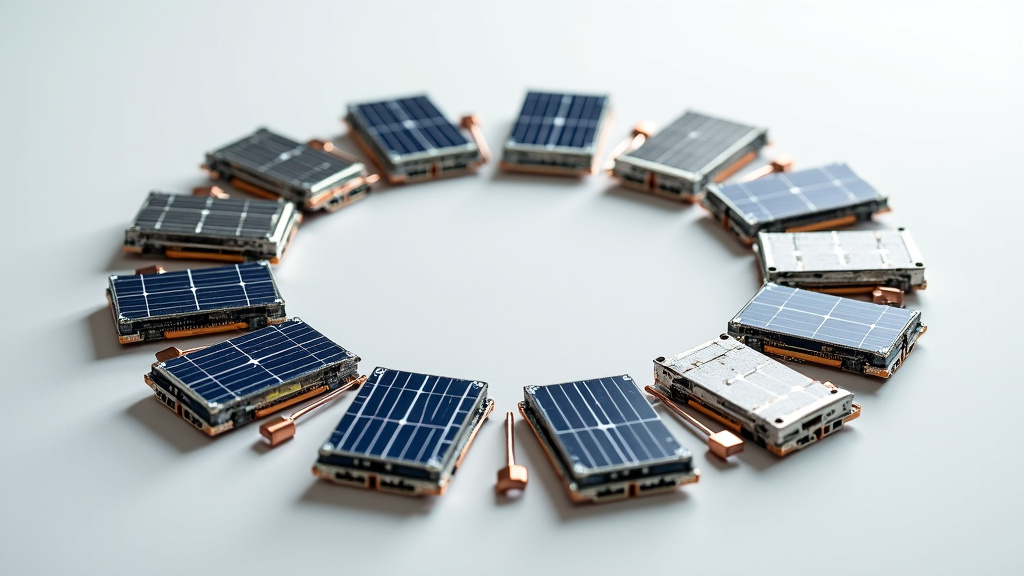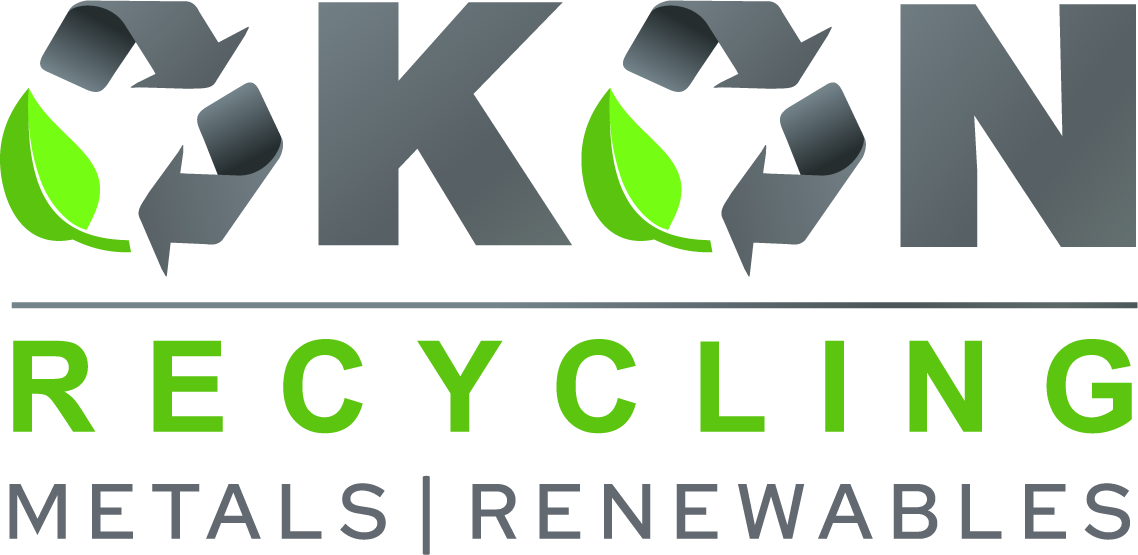5901 Botham Jean Blvd, Dallas, TX 75215
The Environmental Benefits of Solar Panel Recycling
February 13, 2025Did you know that by 2050, solar panel waste could reach 78 million tonnes globally? As we embrace solar energy for a cleaner future, we must also address the environmental impact of panels reaching the end of their lifespan. Without effective recycling, millions of panels could end up in landfills, undermining the very sustainability they were designed to promote.
Solar panel recycling offers a smart, sustainable solution. By recovering valuable materials like silicon, glass, and rare metals, we can reduce waste, lower greenhouse gas emissions, and decrease the demand for newly mined resources. In fact, modern recycling technologies can reclaim up to 95% of semiconductor materials and 90% of glass, significantly shrinking the solar industry’s carbon footprint.
At Okon Recycling, we specialize in recycling and repurposing solar panels, ensuring that these essential materials stay in use rather than becoming environmental burdens. By closing the loop on solar panel production and disposal, we’re not just generating clean energy—we’re creating a truly sustainable energy ecosystem.
In this article, we’ll explore the environmental benefits of solar panel recycling and how it’s shaping the future of renewable energy. Join us in rethinking solar waste and making clean energy even greener.
Innovative Technologies in Solar Panel Recycling

The solar energy industry is rapidly advancing, bringing challenges in managing end-of-life solar panels responsibly. Fortunately, advanced recycling methods are leading to more efficient and eco-friendly solutions, transforming how we recover valuable materials from decommissioned solar panels.
Mechanical recycling, a well-established method, has significantly improved in recent years. This process involves physically breaking down solar panels into components. Advanced machinery now separates materials with greater precision, increasing the purity of recovered substances like glass, aluminum, and silicon.
Chemical recycling marks another leap forward in solar panel recycling technology. This method uses chemical processes to break down complex materials into their basic components. Chemical recycling offers massive, untapped market potential for recycling previously incompatible materials, such as those found in food-grade and medical-grade packaging.
Laser Ablation: A Game-Changer in Material Recovery
One of the most exciting developments in solar panel recycling is laser ablation technology. This cutting-edge method uses high-powered lasers to precisely remove layers of material from solar panels, allowing for accurate separation of different components.
Laser ablation is especially effective for recovering thin-film materials used in some solar panels. These films often contain rare and valuable elements that are difficult to extract using traditional methods. By using lasers, recyclers can target specific layers without contaminating other materials.
The precision of laser ablation also means less energy is wasted in the recycling process, translating to a smaller environmental footprint. Additionally, the recovered materials are often of higher quality, making them more valuable for reuse in new solar panels or other applications.
Researchers are continually refining laser ablation techniques to make them more cost-effective and scalable for large-scale recycling operations. As this technology matures, it could significantly increase the recovery rates of critical materials from solar panels.
The Benefits of Advanced Recycling Technologies
These innovative recycling methods bring numerous benefits to the solar industry and the environment. By recovering a higher percentage of materials, these technologies reduce the need for raw material extraction, lessening the environmental impact of solar panel production.
Advanced recycling also helps address the growing concern of solar panel waste. As the first generation of large-scale solar installations reaches the end of its lifespan, efficient recycling solutions are crucial to ensure valuable resources aren’t lost to landfills.
Moreover, improved recycling methods contribute to the circular economy of solar energy. Recovered materials can be used to manufacture new solar panels, reducing the overall carbon footprint of solar energy production. This closed-loop system aligns perfectly with the renewable energy goals that solar power represents.
| Recycling Method | Advantages | Disadvantages |
|---|---|---|
| Mechanical Recycling | Lower greenhouse gas emissions, established infrastructure, handles common plastics | Limited to certain plastic types, can’t process contaminated plastics |
| Advanced Recycling | Can process a wider range of plastics, handles contaminated materials | Higher energy consumption, dependent on energy source |
| Hydrometallurgy | Lower global warming potential | Not specified |
| Glycolysis | Outperforms virgin PET in metrics | Not specified |
| Methanolysis | Scores above virgin PET | Not specified |
Challenges and Future Developments
Despite the promise of these advanced recycling technologies, challenges remain. The cost of implementing new recycling methods can be high, particularly for emerging technologies like laser ablation. However, as these processes become more refined and widely adopted, costs are expected to decrease.
Another challenge is the diversity of solar panel designs and materials. As solar technology evolves, recyclers must adapt their methods to handle new types of panels efficiently. This requires ongoing research and development in recycling technologies.
Looking to the future, we can expect further innovations in solar panel recycling. Researchers are exploring new chemical processes that could make recycling even more efficient. Additionally, there’s growing interest in designing solar panels with recycling in mind, making future recycling efforts easier and more effective.
The advancement of recycling technologies is crucial for the long-term sustainability of the solar industry. As these innovative methods continue to evolve, they promise to make solar energy an even cleaner and more circular form of renewable power. By embracing these technologies, we can ensure that solar panels not only generate clean energy during their lifetime but also contribute to a more sustainable future at the end of their use.
Economic Impacts of Solar Panel Recycling

As the solar industry grows, the need for effective recycling solutions for end-of-life panels increases. Solar panel recycling not only benefits the environment but also offers significant economic advantages, particularly in job creation and resource efficiency.
The International Renewable Energy Agency projects that by 2030, the global value of recoverable materials from recycled solar panels will reach $450 million. This amount equates to the raw materials needed to produce approximately 60 million new panels, highlighting the potential for cost savings and resource conservation.
Job creation is a key economic benefit of solar panel recycling. The process requires skilled workers for various tasks, from collection and transportation to dismantling and material recovery. As the industry expands, it’s expected to create thousands of new green jobs across the supply chain, contributing to local economic growth and sustainability efforts.
Resource Efficiency and Cost Reduction
Recycling solar panels allows for the recovery of valuable materials such as silicon, glass, and metals. According to industry experts, up to 96% of the silicon from panels can be reclaimed and reused. This high recovery rate reduces the need for virgin materials and lowers production costs for new panels.
The cost-saving potential is significant. As recycling technologies improve, expenses associated with panel disposal are expected to decrease. Currently, recycling costs range from $20 to $24 per 300-watt DC panel, which is less than 5% of a typical system installation cost.
Market Growth and Innovation
The solar panel recycling industry is poised for substantial growth. As more panels reach the end of their lifespan, the demand for recycling services will increase, driving innovation and efficiency in recycling processes. This growth is expected to create new markets for recovered materials and spur technological advancements in panel design for easier recycling.
Investments in recycling infrastructure and technology will likely lead to more efficient and cost-effective recycling methods. This will further reduce costs and increase the economic viability of solar panel recycling, creating a positive feedback loop for industry growth.
| Year | Recyclable Material Value | Percentage of Solar PV Investments |
| 2022 | $170 million | 0.08% |
| 2030 | $2.7 billion | 6% |
| 2040 | Projected 27 million tonnes of waste | 6% of investments |
| 2050 | $80 billion | Not specified |
Economic Benefits for Consumers and Businesses
For consumers and businesses, the economic impacts of solar panel recycling extend beyond job creation and resource efficiency. As recycling becomes more prevalent, it may lead to reduced costs for new solar installations, making renewable energy more accessible to a broader range of consumers and businesses.
Additionally, companies that embrace solar panel recycling may benefit from enhanced brand reputation and potential tax incentives, further contributing to their bottom line while supporting sustainable practices.
Overall, solar panel recycling presents a win-win scenario for the economy and the environment. By fostering job creation, reducing material costs, and spurring innovation, it paves the way for a more sustainable and economically vibrant future in renewable energy.
Challenges in Solar Panel Disposal and Recycling

As the solar energy industry rapidly expands, a new challenge arises: the proper disposal and recycling of solar panels at the end of their lifespan. While solar power provides clean, renewable energy, the panels themselves present unique waste management issues that must be addressed to maintain the industry’s environmentally friendly reputation.
A primary hurdle in solar panel recycling is the lack of standardized protocols across the industry. With various manufacturers using different materials and designs, developing a universal recycling process has proven difficult. This lack of standardization leads to inefficiencies and increased recycling costs.
The economic viability of recycling solar panels remains a major obstacle. According to a report by the National Renewable Energy Laboratory (NREL), recycling a typical residential solar panel can cost between $20 and $30, while landfill disposal costs only $1 to $2 per panel. This stark cost difference often results in improper disposal, with less than 10% of decommissioned panels in the United States and European Union being recycled.
Decentralized Usage and Collection Challenges
The decentralized nature of solar panel installations presents another significant challenge for efficient recycling. Unlike other electronic waste, solar panels are scattered across diverse locations, from residential rooftops to large-scale solar farms. This dispersed distribution complicates collection and transportation to recycling facilities, making it both logistically complex and expensive.
Compounding this issue is the lack of widespread recycling infrastructure. Many regions lack local recycling facilities, necessitating long-distance transportation of panels for proper processing. For instance, Florida, lacking in-state recycling options, must send its decommissioned panels to facilities in South Carolina, further increasing costs and environmental impact.
Material Recovery and Processing Complexities
Solar panels contain a variety of materials, including glass, aluminum, silicon, and small amounts of valuable metals like silver and copper. The complex layered structure of these panels, designed for durability and efficiency, ironically makes them challenging to disassemble and recycle. Current recycling processes struggle to achieve high purity levels in material recovery, particularly for valuable components.
Advanced recycling techniques show promise, with some facilities now able to recover up to 95% of panel materials. However, these methods often come with higher processing costs, creating a situation where environmental benefits must be weighed against economic feasibility.
Real-World Case Studies
The challenges of solar panel recycling are not merely theoretical. In Washington state, the first U.S. jurisdiction to mandate solar panel recycling, implementation has been slow due to the complexities involved. The state’s program, while groundbreaking, has faced hurdles in establishing efficient collection systems and processing facilities.
In Europe, countries like Germany and France have made strides in solar panel recycling through extended producer responsibility schemes. However, even these advanced programs face ongoing challenges in achieving economically viable recycling rates at scale.
Potential Solutions
Addressing these challenges requires a multifaceted approach. Here are some potential solutions:
- Develop industry-wide design standards to facilitate easier disassembly and recycling
- Invest in research and development of more efficient, cost-effective recycling technologies
- Implement extended producer responsibility programs to ensure manufacturers play a role in end-of-life management
- Create incentives or regulations to make recycling more economically competitive with landfill disposal
- Establish regional recycling hubs to reduce transportation costs and improve collection efficiency
- Promote the development of a secondary market for recovered materials to improve recycling economics
As the solar industry matures, addressing these recycling challenges becomes increasingly crucial. By investing in sustainable end-of-life solutions now, the sector can ensure that solar energy remains a truly clean power source throughout its entire lifecycle. The path forward requires collaboration between manufacturers, policymakers, and recycling innovators to create a circular economy for solar panels.
| Method | Cost per Panel | Net Cost |
| Recycling | $20-$30 | $8-$27 |
| Landfill Disposal | $1-$2 |
The Circular Economy and Solar Panel Recycling

The circular economy is a continuous loop of resource use. Unlike the traditional ‘take-make-dispose’ linear model, it emphasizes keeping resources in use for as long as possible, extracting maximum value, and then recovering and regenerating products and materials at the end of their service life. It’s sustainability amplified.
Solar panels, the stars of renewable energy, exemplify this circular approach. These high-tech devices typically last 25-30 years, but what happens when they reach the end of their lifespan? Recycling steps in, turning potential waste into valuable opportunities.
The Solar Panel Recycling Process: A Second Life for Sun-Catchers
When solar panels retire from their rooftop duties, they begin a new journey. First, they are carefully dismantled. The aluminum frames and junction boxes are removed and fed into established recycling streams. It’s like sending them back to school—they’ll emerge as new products soon.
Next comes the exciting part—the layers of glass, silicon cells, and metals are separated using innovative techniques. It’s like unpacking a high-tech lasagna, with each layer holding valuable materials. The glass, which makes up about 75% of the panel, can be recycled into new glass products. The silicon cells, the core of the solar panel, can be repurposed for new panels or other industries.
The real treasure hunt is for the trace amounts of silver, copper, and other valuable metals within. Using advanced chemical and electrical processes, these precious materials are extracted and purified. It’s like panning for gold, but instead of a river, we’re sifting through old solar panels!
The Bright Side of Solar Recycling: Economic and Environmental Benefits
This recycling process isn’t just good for the environment; it’s beneficial for the economy too. According to the International Renewable Energy Agency (IRENA), the value of recoverable materials from solar panel waste could exceed $15 billion by 2050. This represents a whole new industry waiting to bloom.
Moreover, recycling solar panels significantly reduces the need for raw material extraction. This means less mining, less energy consumption, and less environmental disruption. It’s like giving Mother Nature a well-deserved break while still powering our modern lives.
The circular economy approach to solar panels also creates jobs. From collection and dismantling to high-tech material recovery, the recycling process opens up new employment opportunities. It’s a beneficial situation—good for the planet and good for people.
Challenges and Future Outlook: Navigating the Path to Perfect Circularity
Of course, the road to a fully circular solar industry isn’t without challenges. Current recycling technologies are still evolving, and the process can be costly. There’s also the challenge of creating efficient collection systems for end-of-life panels, especially in areas with dispersed solar adoption.
But the future looks promising. Researchers are developing more efficient recycling technologies, and some manufacturers are designing new solar panels with recycling in mind. It’s like they’re writing the disassembly instructions right into the product!
Governments are also stepping up, with some regions implementing regulations that mandate solar panel recycling. These policies are crucial in creating the infrastructure and incentives needed to make solar panel recycling a standard practice.
As we move forward, the circular economy principles applied to solar energy will play a vital role in ensuring that this clean energy source remains truly sustainable from beginning to end. It’s not just about generating clean energy today; it’s about securing a cleaner, brighter future for generations to come.
Conclusion: The Role of Recycling in Advancing Sustainability

Throughout this article, we have highlighted how solar panel recycling is essential for a sustainable future. This practice directly tackles the environmental challenges posed by end-of-life solar panels while promoting a circular economy.
Companies like Okon Recycling lead this green initiative by developing innovative solutions for recycling solar panels. Their work not only reduces the environmental impact of discarded panels but also recovers valuable materials for reuse in new manufacturing processes, conserving natural resources and reducing energy consumption.
The circular economy model, promoted by organizations such as Okon Recycling, represents a shift in waste management and resource utilization. By implementing advanced recycling technologies, these industry leaders set new standards for sustainability in the solar energy sector.
The future of solar panel recycling is promising. As technology advances and awareness grows, we can expect even more efficient and cost-effective recycling solutions. This progress is crucial for supporting the expansion of solar energy while minimizing its environmental footprint.
However, the success of these initiatives relies not only on recycling companies but also on the participation of everyone in the solar energy ecosystem. From manufacturers and installers to end-users and policymakers, each has a role in ensuring responsible management of solar panels throughout their lifecycle.
To learn more about sustainable solar panel recycling practices or explore Okon Recycling’s innovative solutions, visit www.okonrecycling.com or call 214-736-9509. Let’s work together for a brighter, more sustainable future for all.
